Battle of Bomarsund
| ||||||||||||||||||||||||||||||

The Battle of Bomarsund, in August 1854, took place during the Crimean War, when an Anglo-French expeditionary force attacked a Russian fortress. It was the only major action of the war to take place at Bomarsund in the Baltic Sea.
Background
Bomarsund was a 19th-century fortress, the construction of which had started in 1832 by Russia in Sund, Åland Islands, in the Baltic Sea. Bomarsund had not been completed (only two towers of the planned twelve subsidiary towers had been completed). When the war broke out the fortress remained vulnerable especially against forces attacking over land. Designers of the fortress had also assumed that narrow sea passages near the fortress would not be passable for large naval ships; while this assumption had held true during the time of sailing ships, it was possible for steam powered ships to reach weakly defended sections of the fortress.[3]
First battle
On 21 June 1854, three British ships bombarded the Bomarsund fortress. Artillery from the shore, however, responded and, while both sides suffered some damage, the casualties were light. The first battle was indecisive. During the battle, Charles Davis Lucas tossed overboard a shell which had landed on board. The shell exploded before it reached water. For saving his ship he was the first man to be awarded the Victoria Cross.[3]
Second battle
While the first battle had been a brief clash and artillery duel, the second battle was a different affair. By the end of July 1854, a British fleet of 25 ships had surrounded the fortress and only waited for the French ground troops to arrive. Both defender and attacker had acknowledged that the fort could not be defeated by naval forces alone and made preparations accordingly, Russian forces destroyed the surrounding countryside in an effort to force British and French forces break away from the assumed siege.[3]
Landing on 8 August, the British troops established a battery of three 32-pounder guns on a hill, the French establishing several batteries. On 13 August 1854, the French artillery opened fire on a tower and by the end of the day were in a position that while artillery suppressed the defenders of subsidiary tower of Brännklint, French infantry assaulted it.[4]:420 Defenders found their position to be hopeless and withdrew the bulk of their forces to the main fort leaving only small detachment behind to supervise demolition of the tower. While French troops managed to capture the tower before it was demolished, it did not save the tower since the Russian artillery now opened fire at the captured tower and on 15 August 1854 scored a hit to the gunpowder magazines. The resulting explosion demolished the tower.[3]
The second tower, Notvik, was also lost on 15 August 1854 after British guns opened fire from their hill opposite to the tower. After eight hours of bombardment they managed to create a gaping hole to the fort. After most of the guns had been lost commandant of the tower surrendered to the British and French forces.[3]
The bombardment of the main fortress started late on 15 August 1854 with land based guns and the navy opening fire.[4]:420 With only a few guns capable of firing in the direction of the bombarding ships, the Russian forces hoped for the French and British forces to attack over land. However, after the bombardment continued into the 16 August without any indication of landings, it became apparent to the Russian commander that British and French intended to reduce the fortress with artillery fire. As the situation appeared hopeless, Bomarsund surrendered on 16 August 1854.[3]
The early surrender came as a surprise of the French and British. 2,000 men laid down their arms and became prisoners.[4]:420
Aftermath

After the surrender, French and British forces demolished the fortress. British engineers remained until mid-September to ensure it could not be easily rebuilt.[4]:421
Three hundred Finnish grenadiers defending the fortress were captured and imprisoned in Lewes in the United Kingdom. They were later allowed to return to Finland, and they returned with a song telling about their battles and imprisonment, called the War of Åland ("Finnish: Oolannin sota, Swedish: "Det Åländska kriget). The Russian Memorial was erected in Lewes in 1877 to honour those who died in captivity.
In the Treaty of Paris 1856, the entire Åland Islands were demilitarized, which is a status that has been preserved until this day.
The Bomarsund Bridge connects Bomarsund to the Prästö island.
Victoria Cross recipients
In addition to Charles Davis Lucas several other Victoria Crosses were awarded in the Baltic Theater during the Crimean War.
Other VC recipients for action in the Baltic Sea:
- John Bythesea - 1854; Åland Islands
- William Johnstone - 1854; Åland Islands
- George Ingouville - 1855; Fort of Viborg
- George Dare Dowell - 1855; Fort of Viborg
Trivia
- A coal mine in Northumberland was named after the battle; the neighboring village still carries the name Bomarsund.
- In 2007 Orlando Gough's opera The Finnish Prisoner which tells about the events of 1854 had its premiere performance in Lewes.
References
- 1 2 Tyrrell, Henry (1858). The History of the War with Russia. Volume 3. p. 334.
- ↑ Troupes de Marines.org
- 1 2 3 4 5 6 Robins, Graham (2004). "Bomarsund - Imperiumin etuvartio" [Bomarsund - Empire's vanguard] (PDF) (in Finnish). Mariehamn, Åland, Finland: Mariehamns Tryckeri.
- 1 2 3 4 Porter, Maj Gen Whitworth (1889). History of the Corps of Royal Engineers Vol I. Chatham: The Institution of Royal Engineers.
External links
Coordinates: 60°12′44″N 20°14′18″E / 60.21222°N 20.23833°E
